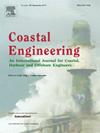Numerical analysis and prediction of the effect of debris initial configurations on their dispersion during extreme-hydrodynamic events
IF 4.2
2区 工程技术
Q1 ENGINEERING, CIVIL
引用次数: 0
Abstract
Tsunamis and other extreme hydrodynamic events have the potential to transport large debris that, along with the flow, are capable of causing severe damage to coastal structures and infrastructures. Therefore, modelling such processes is essential when assessing the multiple hazards associated to this type of events. In harbour areas, transport inland of shipping containers and subsequent impacts are relevant examples of waterborne debris hazards. The present work addresses two gaps in the scientific research of this problem using numerical methods; the understanding of the effect of containers initial layouts and that of the flow impact angle on the transport and diffusion. To fill these gaps a numerical study was carried out using idealised flow conditions. To this end a Smoothed Particles Hydrodynamics solver (DualSPHysics), coupled with a Discrete Element Method model (Project CHRONO), was used and initially validated with experiments published in the literature. Subsequently, four layouts commonly used in shipping containers yards were simulated, including incident flow depth and impact angle variability, resulting in 76 total simulations. The results were analysed in terms of normalised standard deviation and normalised range differences with respect to the initial values of both parameters. These parameters were related to the flow impact angle, water depth to containers height ratio , and normalised displacement of the container clusters centroids. Standard deviation and range are shown to reach, for almost all results, a quasi-steady state by the end of the simulations. It is shown that the standard deviation and range are more sensitive to the impact angle for . In this case, the configurations with flow impacting orthogonally to one of the containers axes show larger values of the two parameters than for intermediate angles. For larger values, drives the standard deviation and range, independently from the impact angle. is shown to be a physical parameter that well describes the relative importance of dispersion and advection of containers transported in extreme hydrodynamic events. Finally, existing relationships, that assume an infinite growth of the range, are shown to overestimate numerical results at the stage in which dispersion does not grow further. Two new regression formulae are numerically derived to predict the dispersion parameters at this stage. They include the effects of the cluster layout, impact angle and making them a valid alternative to existing relationships.
极端水动力事件中碎片初始形态对碎片弥散影响的数值分析与预测
海啸和其他极端的水动力事件有可能携带大量的碎片,这些碎片和水流一起,可能对沿海建筑和基础设施造成严重破坏。因此,在评估与此类事件相关的多重危害时,对此类过程进行建模是必不可少的。在港区,集装箱的内陆运输及其影响是水运碎片危害的相关例子。目前的工作用数值方法解决了这一问题的科学研究中的两个空白;了解集装箱初始布局和气流冲击角对运输和扩散的影响。为了填补这些空白,采用理想流动条件进行了数值研究。为此,使用了光滑粒子流体动力学求解器(dualspphysics)和离散元素方法模型(Project CHRONO),并通过发表在文献中的实验进行了初步验证。随后,对集装箱堆场常用的四种布局进行了模拟,包括入射流深度和冲击角变化,共进行了76次模拟。根据两个参数初始值的归一化标准差和归一化极差对结果进行分析。这些参数与水流冲击角、水深与容器高度比DhR以及容器簇质心的归一化位移有关。在模拟结束时,几乎所有结果的标准偏差和范围都达到了准稳定状态。结果表明,当DhR≤1.7时,标准差和极差对冲击角更为敏感。在这种情况下,气流垂直冲击容器轴的配置比中间角度的配置显示出更大的两个参数值。对于较大的数值,DhR驱动标准差和范围,独立于撞击角。DhR是一个物理参数,可以很好地描述在极端水动力事件中运输的容器的弥散和平流的相对重要性。最后,假设范围无限增长的现有关系在色散不再进一步增长的阶段过高估计了数值结果。数值推导了两个新的回归公式来预测这一阶段的色散参数。它们包括集群布局,冲击角α和DhR的影响,使它们成为现有关系的有效替代。
本文章由计算机程序翻译,如有差异,请以英文原文为准。
求助全文
约1分钟内获得全文
求助全文
来源期刊

Coastal Engineering
工程技术-工程:大洋
CiteScore
9.20
自引率
13.60%
发文量
0
审稿时长
3.5 months
期刊介绍:
Coastal Engineering is an international medium for coastal engineers and scientists. Combining practical applications with modern technological and scientific approaches, such as mathematical and numerical modelling, laboratory and field observations and experiments, it publishes fundamental studies as well as case studies on the following aspects of coastal, harbour and offshore engineering: waves, currents and sediment transport; coastal, estuarine and offshore morphology; technical and functional design of coastal and harbour structures; morphological and environmental impact of coastal, harbour and offshore structures.
 求助内容:
求助内容: 应助结果提醒方式:
应助结果提醒方式:


